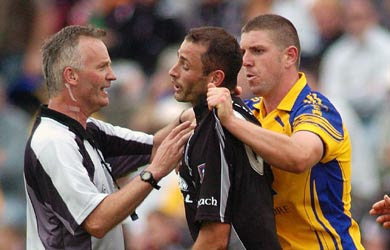 I don’t listen to music very much anymore. I certainly don’t buy it. I’ve been moving house lately, and as I pack up the CDs and go through them I look at the odd one and think “why in God’s name did I buy this crap?” And then the invariable answer comes – because I read in a magazine that it was cool.
I don’t listen to music very much anymore. I certainly don’t buy it. I’ve been moving house lately, and as I pack up the CDs and go through them I look at the odd one and think “why in God’s name did I buy this crap?” And then the invariable answer comes – because I read in a magazine that it was cool.I name and shame: Trout Mask Replica, by Captain Beefheart. Forget everything you read – it’s garbage. There is no other word.
I used to buy a lot of music, and then, slowly, I began to find that there was less and less stuff I wanted to listen to. Once you’ve caught up on the classics – Stones, Who, Beatles, you know yourself – you find that the current crop doesn’t really measure up. Is there any record that sounds quite as revolutionary as Astral Weeks or Forever Changes still does? And it’s been forty years since those records were made. No progress in forty years - two generations, at least - is not a great sign.
It’s doubly disappointing when you realise that the so-called classics don’t stand the test of time that well either. There will always be revolutionary artistic endeavour, like the two I’ve mentioned already, but there’s nothing to revolutionary about something that was influential forty years ago. After forty years, the revolution becomes the establishment. In his marvellous series on Twenty Century Greats, Howard Goodall pointed out just how revolutionary the Beatles were, but I remember when the DEC VAX computers were the cat’s pyjamas but I don’t get the vapours today at my amazing home wireless internet access. It’s just part of the wallpaper now. Ozimandias, King of Kings…
Some of An Spailpín’s friends are fluttering with anticipation at the prospect of attending the Electric Picnic (or Siamsa Cois Laoi 3.0, if you like) this weekend. It must be a lifestyle thing. I looked at the list of bands playing and was able to file them all under two species; who the hell are they, and I thought they were dead. If most of that bunch were playing in the back garden not only would I draw the curtains, but I’d seal up the windows as well, just in case, nasty old humbug that I am.
A friend of the blog was shocked last week when I told him I don’t listen to music anymore. It’s not so much that I don’t listen to it, as that I don’t look to it for the same meaning I once did. Music is still vital to him (although he’d a be longshot to be seen at the Picnic as well, I might add), but for me the magic is broken. I liked the Kaiser Chiefs last year, but when I see that their songs are being performed better currently by bubblegum pop acts like Lily Allen and Girls Aloud, well, a man tends to see them for what they are.
“Cabaret music” used to be the rock and rollers’ great sneer to the squares – Paul A. Rothschild refused to produce The Doors’ LA Woman because it was “cocktail music.” Now, the insult has no frisson anymore; in fact, if you are entertaining this weekend, I’m quite sure a spin of LA Woman while the digestifs are being served will go down terribly well. We are all into cocktail music now – has anybody seen Snorah Jones’ record sales lately?
Besides, rock and roll is past its sell by date. Sinatra sang saloon songs for grown-ups; it’s hard to take Mick Jagger seriously when he sings “I Can’t Get No Satisfaction” for an audience who are thinking “I Can’t Get No (Nursing Home) Subvention.” The Sinatra era is dead as well, as people have lost the art of both writing and appreciating that sort of urbane, sophisticated lyric and melody. Wicked was the big Broadway hit musical last year, but the songs are, uniformly, very middling indeed. Send in the Clowns? Don’t bother, they’re here.
Bono likes to tell us that rock and roll can save the world. Well Paul, it’s had half a century now since Bill Haley first rocked around the clock – how do you think it’s doing so far? Any stir?
Freddie Mercury had it figured from the start. Freddie knew that this crack about rock and roll saving the world was all blather. “My songs are like Bic razors,” he said. “For fun, for modern consumption. You listen to it, like it, discard it, then on to the next. Disposable pop.”
Good old Freddie. He knew that life is a cabaret. He put on a show, but he never claimed them to be any different to the ones George Formby used to do at Blackpool pier in the 1930s. Nothing wrong with George, and enough right with him not to pretend to be anything he’s not. As for the rest of the shapers, well, we’ll have to wait and see. Enjoy the picnic if you’re going, but try not to join any movements or cults. And to end on a happy note, here’s Freddie singing one of those disposable pop songs, one of An Spailpín’s own favourites (the hopeless old softy), Love of My Life. And isn’t it interesting to note that, as Freddie’s voice soars and he leads the singalong, there’s no emotion there at all? Freddie knew what he was doing alright. God have mercy on him.
Technorati Tags: culture, music, Electric Picnic, Freddie Mercury








